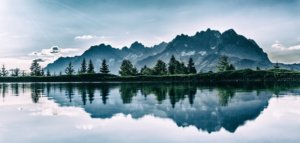Enjoy, Don’t Destroy: Social Media’s Impact on the Outdoors
Published on November 1, 2017, at 9:19 a.m.
by Hope Runyan.
Modern technology puts the entire world in the palm of our hands. With the evolution of social media, you can share your picture-worthy breakfast and current location online with thousands of people in an instant. But how does this mass connection affect the places to which we are bringing attention?
What is a geotag?
Geotagging, defined by Techopedia, is adding a geographical location to media in the form of metadata. It’s most commonly used for photographs, and it includes latitude and longitude coordinates. Basically, geotagging is a fast way to share the exact location of places — which can be helpful for people seeking precise information.
Many social media platforms offer geotagging services, including Facebook, Snapchat and Instagram. This form of location sharing has proved to be very useful for restaurants and other food venues; by letting your audience know where to get that delicious-looking grilled cheese, you are making it easier than ever to establish a connection between vendor and consumer.
But what about the outdoors?
Using location services outside builds a similar connection. For those who have never been inclined to explore national parks or forests, or felt welcome in the outdoor community, this is a great way to foster a relationship. It’s easy to look at a picture of a beautiful sunset spot in the mountains and think, “I’d like to go there!” But what follows is the most important part of enjoying the outdoors — education and preparation.
“Nature can only handle so much of us,” said James Dilzell, a student at The University of Alabama who spent his summer teaching outdoor education as a naturalist in Avon, Colorado.
In addition to educating preschoolers on climate and wildlife, Dilzell also led nature hikes and informed tourists on the immediate environment of that area. After a summer of professionally educating others on the outdoors, he brings up an important point: People don’t always think about the impact they make on the environment.
Whether you’re in a national park or your backyard, it’s likely that you will make an impression on the area, which is why the Leave No Trace program exists. The Leave No Trace Seven Principles provide guidance to enjoy the outdoors in a sustainable way and without manmade damage to an area. Founded in 1994, Leave No Trace has become a staple identity for the outdoor community and exists only to protect the outdoors through education and inspiration.
“In certain cases, some places are being loved to death,” stated Dilzell. On the surface this doesn’t seem like a problem — outdoor enthusiasts just want more people to get outside, right? But when further explored, you can see how people’s use of social media can lead to the detriment of nature. Whether it’s venturing off the trail for a selfie or feeding the wildlife for a cool Facebook post, if certain places are publicized without the regulations for being there, then people are reinforcing negative treatment of the environment.
Take, for example, Hanging Lake in Glenwood Canyon, Colorado.
Hanging Lake is known for its clear, blue water (with an incredibly well-balanced PH level). A two-mile trail leads to the lake where a large log rests on the surface, making a pathway out into the middle. Next to it is a sign that reads, “Please Keep Off The Log.” Nevertheless, hundreds of people take to social media to document their one-of-a-kind picture in front of the waterfalls in the background. These instances aren’t solely reserved for waterfall pictures; the red rocks of the Southwest are also vandalized every year with people’s initials, and later documented on social media.
As someone whose life revolves around being outside and taking care of it, Dilzell hopes for a better way to educate future generations. He agrees that geotagging is a useful tool in helping get more people outside, but argues that without further education people aren’t going to be able to enjoy the outdoors forever.
Does everyone feel this way?
On the flip side, some environmentalists think that while social media can lead to a place being overcrowded, it’s better to just encourage people to get outdoors.
Charles Scribner, executive director of Black Warrior Riverkeeper in Birmingham, Alabama, says that social media has both positive and negative effects on the outdoors, but ultimately is to the betterment of it.
 “Increasingly, it seems that more people are less engaged with the outdoors and seem to be more siloed in front of screens. … Social media exposes people to places that they might not otherwise visit – and might interest them in conserving those places,” said Scribner.
“Increasingly, it seems that more people are less engaged with the outdoors and seem to be more siloed in front of screens. … Social media exposes people to places that they might not otherwise visit – and might interest them in conserving those places,” said Scribner.
Scribner also noted that by simply relying on a picture and geotag, people are cutting out the process of education. That’s why Black Warrior Riverkeeper proactively educates its followers on social media. Each post comes from a conservational standpoint with guidelines on how to enjoy nature responsibly.
Scribner’s biggest concern about social media and geotagging is the lack of education that follows. Littering is one of the easiest ways to ruin nature, and too many individuals take to the outdoors without the basic preparation of bringing a trash bag or knowing how to not leave a trace.
Is Instagram ruining the outdoors?
The combined answer from Dilzell and Scribner — no. While there is much work that needs to be done to better the process of environmental education, social media and geotagging are not killing the environment. By reaching thousands of people in an instant, social media is putting the Earth’s natural wonders right in front of them, and hopefully inspiring some to protect it for future generations to enjoy.





